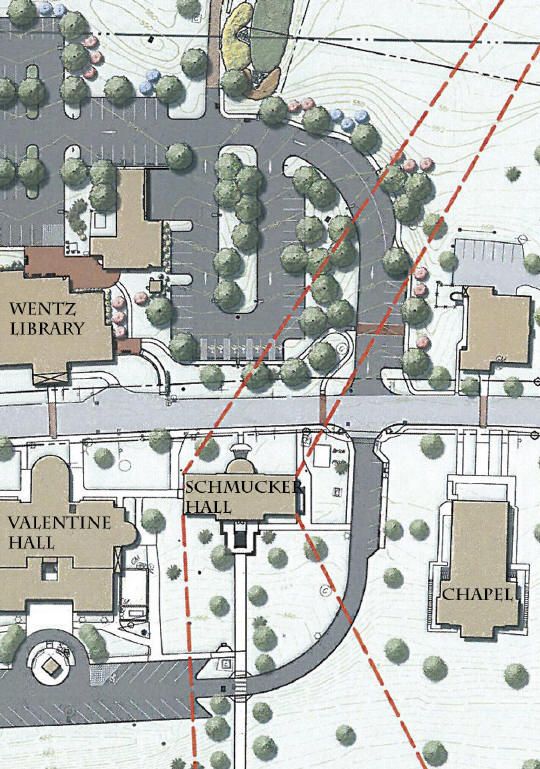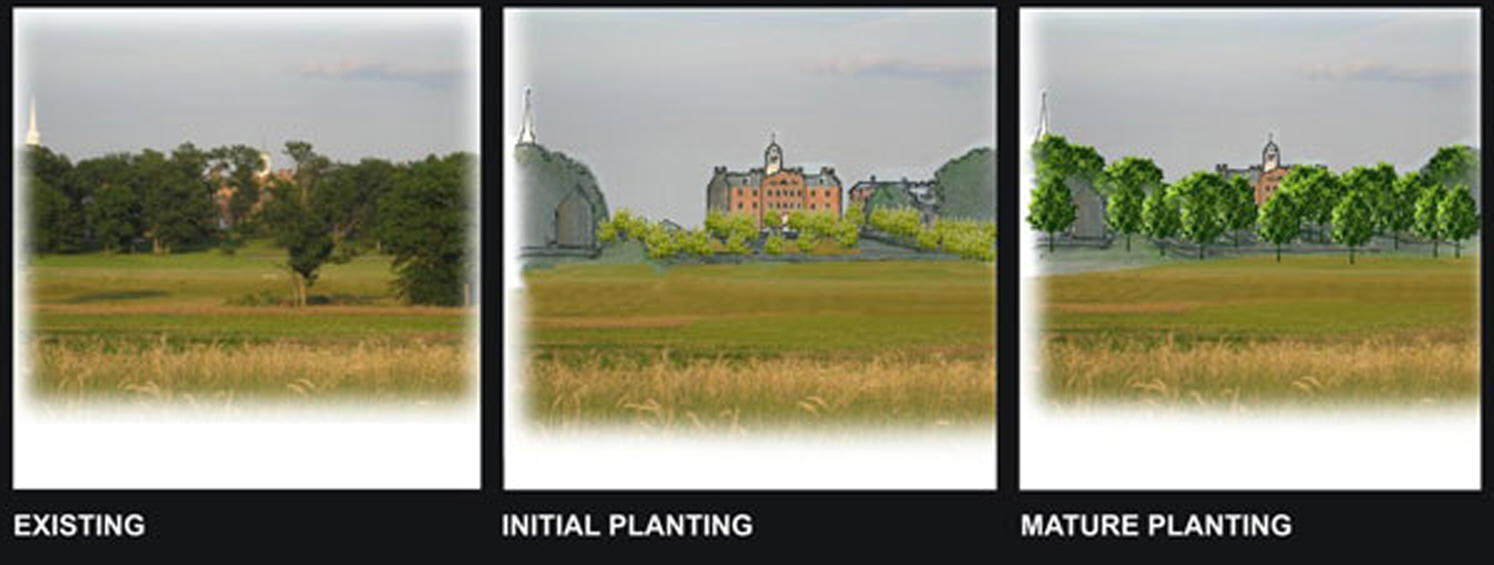(2/14) — By late spring, the west side of Seminary Ridge in Gettysburg will highlight important historic features, reconfigured parking, and a completion of a one mile multiple use historic pathway. The project is set to begin as soon as weather permits.
The project, supported by the Journey Through Hallowed Ground National Scenic Byway program, will redesign traffic flow and redistribute automobile parking to lessen the effect of paved surfaces in critical historic areas and begin to restore the Seminary grove of trees west of the Seminary Ridge roadway. Gettysburg is the northernmost point in the 180
mile historic corridor that runs along Route 15 to Monticello in Virginia.
The project will also complete the one mile multiple use historic pathway that currently loops only through the campus on the eastern slopes of Seminary Ridge. The project removes two tennis courts close to the last line of defense of Seminary Ridge on July 1, 1863, and limits the amount of paved surface to a minimum.
A careful redesign of campus parking relocates high density parking to a place behind the Lutheran Theological Seminary’s A.R. Wentz library. This move cuts in half (34 spaces) the parking spaces in the immediate area of the grove where on July 1, 1863, Union forces made their heroic last stand. Safer pedestrian walkways, ADA parking spaces, and drop
off and pick up areas for bus and transit are included in the design will support the increased visitation to the new Gettysburg Seminary Ridge Museum.

The plan, created by the Seminary and the Seminary Ridge Historic Preservation Foundation (SRHPF), replants two trees for each one of the remaining trees in the grove. Plans for replanting appropriate oak trees in the Seminary grove were aided by the National Park Service’s Olmstead Center for Landscape Preservation. They have recommended native oak
species that will not block the view of the historic seminary building cupola once they mature. Seminary Ridge Historic Preservation Foundation leaders consulted with Gettysburg National Military Park staff in the final planning for the project. A team of historians collaborated on the texts and photos planned for the 18 waysides scattered along the one mile path.

SRHPF officials noted that the few remaining oak and ash trees near the top of the Ridge obscure the building and the cupola which was much more prominent on the horizon in 1863. Photos from the 1860’s and 1880's document the tree height and position and density. During the construction of the first part of the pathway on the Eastern half of the
campus, Seminary officials heard from concerned citizens when the earth was carved up to install depressed areas to collect storm water runoff and recharge the ground water. They also noted that completion of the pathway elicited many more comments of gratitude and appreciation.
"We are losing the grove of trees to age and ash boring insects and the current view is interrupted by concentrated parking of 68 vehicles," said John Spangler, president of the Seminary Ridge Historic Preservation Foundation, a subsidiary of the Lutheran Theological Seminary. "This project will preserve the view shed of Schmucker Hall from the west
and restore a grove- like appearance to the area that now has only about 20 trees left, none of which are historic ‘witness trees’," he added. Spangler also indicated that an information session for neighbors and interested members of the public will be scheduled for early March.
The new Gettysburg Seminary Ridge Museum will open to the public July 1, 2013, and will feature 20,000 square feet of interactive exhibit galleries and educational programming to interpret three major areas of emphasis—none of which are the focus of any other museum in Gettysburg: the pivotal first day of the Battle of Gettysburg on Seminary Ridge; the
care of the wounded and human suffering within the museum building during its use as a Civil War field hospital; and the moral, civic, and spiritual debates of the Civil War era. A one-mile outdoor trail will complement a museum visit with wayside markers. Special exhibits, programs and events will be offered throughout the year.
The Seminary’s president Michael Cooper-White said that "we are thankful for the support and participation of the Journey Through Hallowed Ground historic corridor and delighted to represent a first step in Gettysburg’s active participation in the historic corridor."
The museum project is a joint venture of the Lutheran Theological Seminary at Gettysburg, the Adams County Historical Society and the SRHPF. Design consultants include MM Architects of Lancaster, and ELA Group of Lititz, PA., with Delta Development, Harrisburg, PA assisting with public funding.
Visit the museum’s website at www.seminaryridgemuseum.org for more information on the hours of operation, for a list of grand opening events, and as of March 1st, to purchase advance tickets and cupola tours.